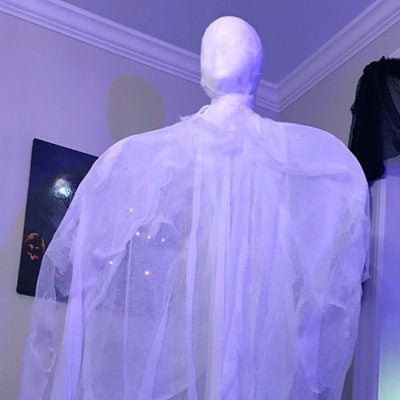How to Make a Spooky Ghost Decoration for the Halloween Season
Halloween is one of the best holidays of the year, and not just because of the candy! It is fun to decorate your home with various creepy crawlies, bats, and more—but sometimes the decorations lack movement and drama. We’ve found a way to add some liveliness into your own haunted house décor with a Lasko fan. In just a few simple steps and with some inexpensive supplies, you’ll have a spooky new addition to your Halloween decorations!
Before we begin, it’s important to prep your work space. Gather your supplies and protect any delicate work surfaces with a drop cloth, newspapers, etc.
Supplies
- 1 fan with adjustable head, like a pedestal or table fan
- White school glue/Mod Podge
- Small paint brush
- 1 foam mannequin head
- 1 wire hanger
- 1 short piece of stiff wire (not shown)
- Craft glue (not shown)
- Package of white cheesecloth, we used about 15 yards
- Scissors
- Clear fishing line
- Wire cutters
- Black light (optional)
Step 1
Step 1 – Attach a piece of wire to the top of the foam head for hanging
To create a loop for hanging your finished ghost, start by adding a bit of craft glue to the ends of your stiff wire and pressing it into the top of the foam mannequin head.
Then, straighten the hook part of the wire hanger, and insert it into the bottom of the mannequin head. Use the wire cutters to cut the bottom of the wire hanger (the widest, horizontal part) in the middle. Bend and shape the wire hanger to form the shoulders and arms of your ghost. If the cut ends of the wire are too sharp, then bend a small section until it’s curled back on itself.
TIP: If you have trouble inserting the wires, use a thin nail to make a small pilot hole. Be sure the pilot hole is smaller than the diameter of the wire so it will stay firmly in place. You can add a dab of craft glue to the holes before inserting the wire for extra strength.
Step 2
Step 2 – Cut several sections of cheese cloth
Cut several sections of the cheese cloth in varying lengths around 3-5 feet, each. Cut jagged edges so the cloth looks tattered and worn. We cut 7 sections for our ghost, but you can add more if you want a more full-bodied ghost. Spread them out individually somewhere aside, but still accessible – you’ll need them soon!
Step 3
Begin gluing layers of cheese cloth to the foam head
Continue adding cheese cloth to cover the face
Dab the brush with glue to define facial details
Next, use a paintbrush to apply the glue or Mod Podge to the mannequin head in sections. Apply a section of cheese cloth to adhere it, leaving the long trailing end to hang down without being glued. If you’re using plain white school glue instead of Mod Podge, add some water until it’s a thinner consistency.
Using your fingers or a dabbing motion with your brush, press the cloth into the details of the face to define the eyes, nose and mouth. Continue adding the sections of cheese cloth around the head until it is completely covered. Allow everything to dry completely.
TIP: Get a helper to put a piece of clear fishing line through the hanging loop so you can hang your ghost to dry
Step 4
Use a fan to create a gentle ghostly breeze
Once the glue has dried completely, hang your ghost and arrange the cheese cloth over the wire hanger to create the ghost’s body. If you would like some additional definition around the ghost’s neck, tie a thin strip of cheese cloth around the neck and let it drape down over the body.
Then place your fan near your ghost, but try to place it somewhere out of sight (we hid ours under a table). Aim the fan toward your ghost, and turn it on a low speed. You might need to make some adjustments to the fan speed, angle, and position to get it just right for your ghost. The perfect positioning will create a gentle breeze that will blow the cheese cloth around like a “real” floating ghost!
TIP: Add some creepy music and turn down the lights (and add a black light if you have one) to make an extra spooky scene!
WATCH: Video of finished Lasko DIY Halloween Ghost in Action
Important Precautions
- Keep your fan’s intake and exhaust open and free from any obstructions. Blocked grills interfere with the proper functioning of your fan.
- Never operate a fan with a damaged cord or plug.
- Always plug your fan directly into a wall outlet and avoid using extension cords, power strips, or other cord-connected devices.

